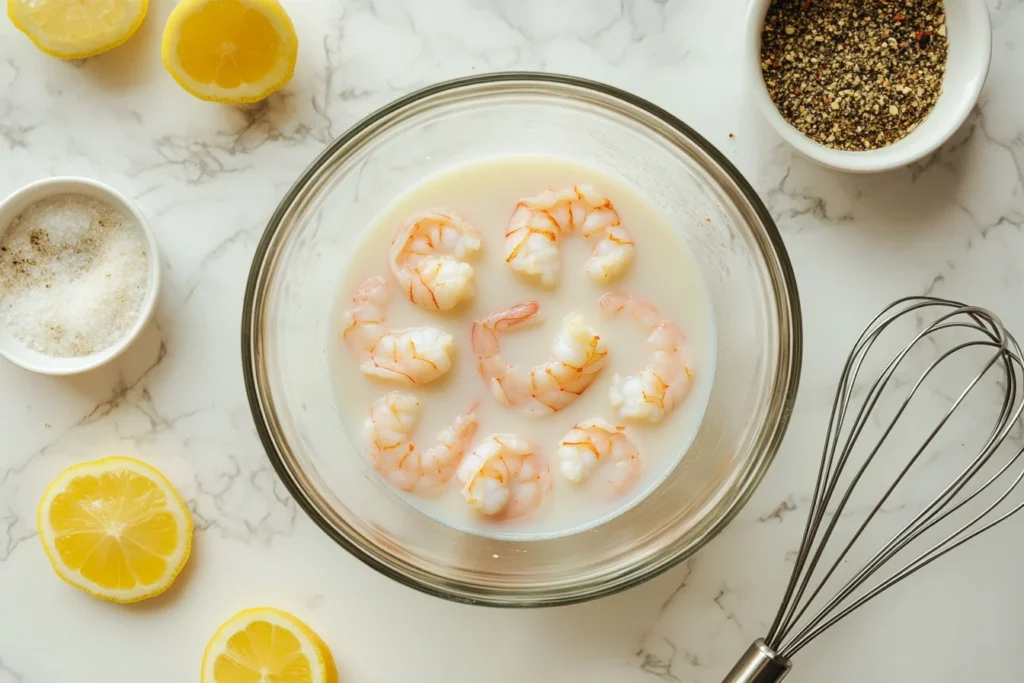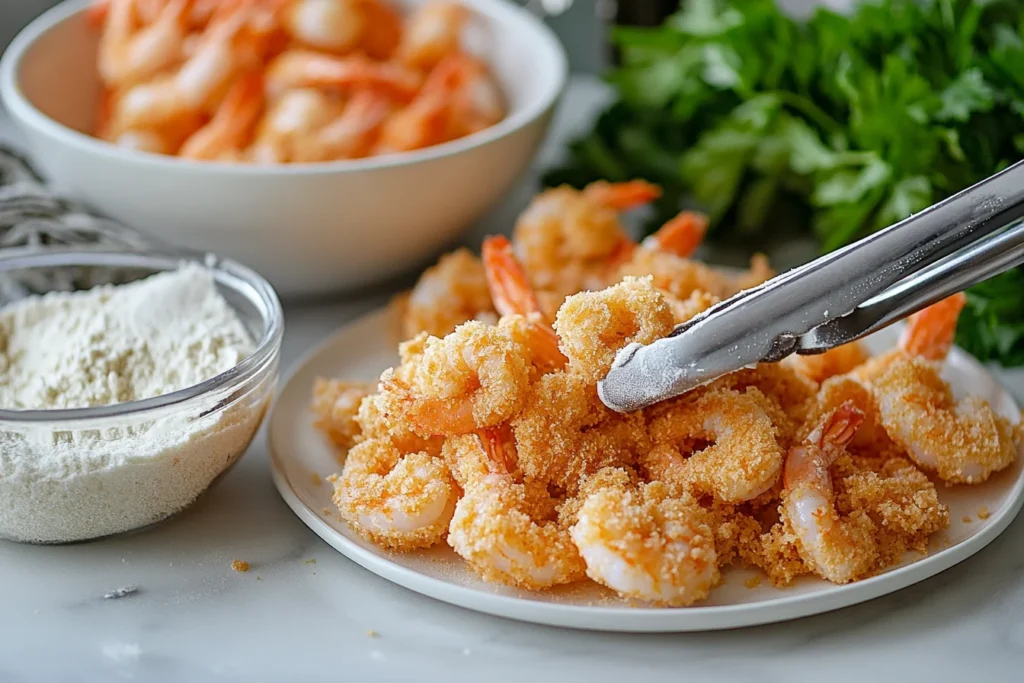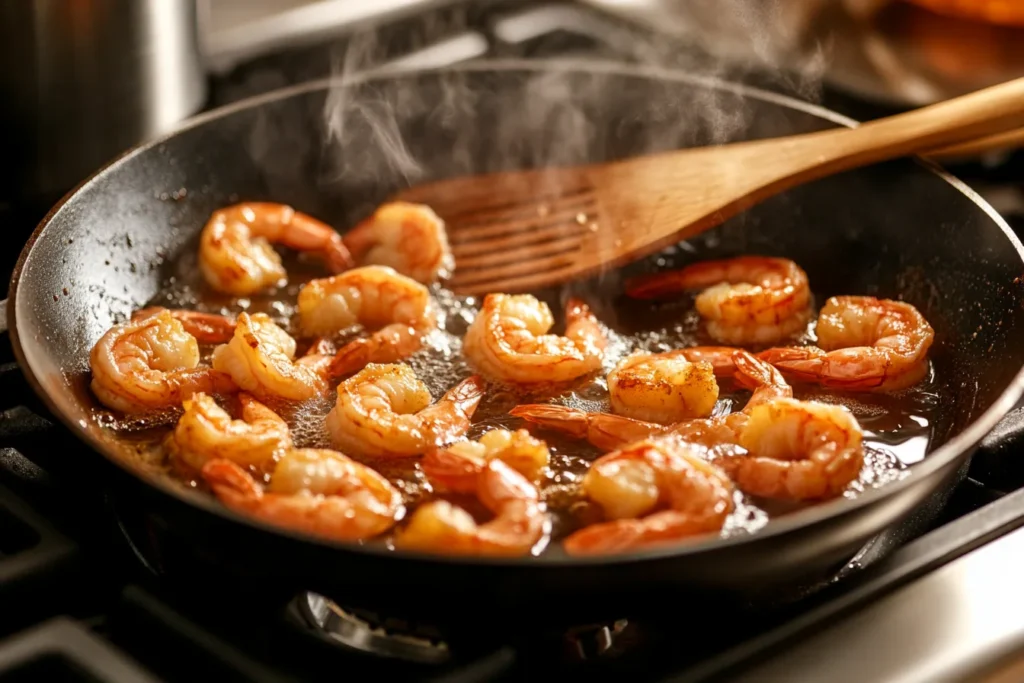Introduction
When preparing fried shrimp, every step matters in achieving that perfect flavor and texture. One often-overlooked step is soaking shrimp in milk before frying. But why do you soak shrimp in milk before frying? This simple yet powerful technique can transform your shrimp dish, enhancing its flavor and texture in ways you might not expect.
In this article, we’ll uncover the reasons behind this culinary practice, delve into the science of how milk interacts with shrimp, and provide a detailed guide to soaking shrimp in milk before frying. If you’re curious about other ways to prepare shrimp, check out our Shrimp Garlic Butter recipe or discover What’s the Tastiest Way to Cook Shrimp? for more cooking inspiration. By understanding the benefits of soaking shrimp in milk, you’ll see how this step can elevate your next shrimp recipe to restaurant-quality perfection.

Table of Contents
The Science Behind Soaking in Milk
To understand why you soak shrimp in milk before frying, it helps to look at the science. Milk contains enzymes and proteins that interact with the shrimp in several beneficial ways.
Casein Proteins: These proteins bind to odor-causing compounds in shrimp, effectively reducing any unwanted fishy smell.
Lactic Acid: Found naturally in milk, it acts as a mild tenderizer, softening the shrimp without making it mushy.
Fat Content: The fat in milk coats the shrimp lightly, ensuring that seasonings stick better during the breading process.
When shrimp are soaked in milk, these components work together to enhance their flavor and texture, creating a dish that’s both flavorful and tender. This step is particularly useful if you’re working with frozen shrimp, which can sometimes carry stronger odors or have a tougher texture.
Neutralizing Odors
A common reason why you soak shrimp in milk before frying is to neutralize any unwanted odors. Shrimp, especially when stored or transported frozen, can develop a slightly fishy smell. This is caused by naturally occurring compounds like trimethylamine, which can linger even after washing.
Milk is an excellent odor neutralizer for shrimp due to its casein proteins. These proteins bind to the odor molecules, effectively removing them. After soaking, the shrimp smell fresher and cleaner, allowing their natural sweetness to shine through during cooking.
For best results:
Use whole milk or 2% milk for maximum casein content.
Soak the shrimp for 20–30 minutes, giving the milk enough time to neutralize the odors.
This simple step ensures that your fried shrimp tastes clean and fresh, without any off-putting smells.
Enhancing Texture
Another key motive why you soak shrimp in milk before frying is the effect it has on texture. Milk’s lactic acid lightly tenderizes shrimp, breaking down hard proteins with out compromising their structure.
Tender shrimp are a trademark of a well-organized dish, and soaking enables obtain that perfect bite. Unlike harsher tenderizing techniques, milk preserves the shrimp’s integrity at the same time as including a subtle creaminess to its surface.
To enhance texture successfully:
Avoid over-soaking; half-hour is normally sufficient.
Pat the shrimp dry after soaking to save you extra liquid at some point of frying.
The end result is shrimp that are tender, juicy, and perfectly prepared for frying, ensuring a pleasing eating experience.
Boosting Flavor
Why do you soak shrimp in milk before frying? One foremost motive is flavor enhancement. Milk no longer only neutralizes odors and tenderizes the shrimp however additionally acts as a flavor carrier. Its fats content material absorbs and complements seasonings applied after soaking.
When shrimp are soaked in milk, the slight sweetness of the milk complements their herbal brininess. Additionally, milk creates a moderate creaminess that pairs beautifully with crispy coatings, making the very last dish taste extra indulgent.
For an extra taste increase:
Add a pinch of salt, garlic powder, or paprika to the milk before soaking.
Marinate the shrimp after soaking to layer additional flavors.
With this approach, you’ll discover that your fried shrimp has a richer, greater complicated taste profile that’s sure to impress.
Step-by-Step Guide to Soaking Shrimp in Milk
Now that we’ve explored why you soak shrimp in milk before frying, let’s look at how to do it. Follow these steps for the best results:
Select Your Shrimp
Use fresh or frozen shrimp. If frozen, thaw them completely before soaking.
Devein and peel the shrimp, leaving the tails on if desired.
Prepare the Milk
Pour whole milk or 2% milk into a bowl, ensuring there’s enough to fully submerge the shrimp.
For added flavor, mix in a pinch of salt, garlic powder, or your favorite seasoning.
Soak the Shrimp
Place the shrimp in the bowl, ensuring they are completely covered by the milk.
Let them soak for 20–30 minutes to neutralize odors, tenderize, and boost flavor.
Drain and Pat Dry
Remove the shrimp from the milk and discard the liquid.
Pat the shrimp dry with paper towels to remove excess moisture.
Season and Bread
Season the shrimp as desired.
Bread them using flour, egg wash, and breadcrumbs or your preferred coating.
Fry to Perfection
Heat oil to 350°F and fry the shrimp until golden and crispy.
Serve immediately with your favorite dipping sauce.

Variations in Milk Types
One interesting aspect of why you soak shrimp in milk before frying is the flexibility in milk types. Different kinds of milk can bring unique flavors and textures to the shrimp.
Whole Milk: The go-to choice for this method, as it contains a balanced fat content that tenderizes and enhances flavor.
Buttermilk: A great alternative for a tangy flavor and stronger tenderizing effect due to its high acidity.
Coconut Milk: Perfect for an exotic twist, adding a subtle sweetness and creamy texture that pairs beautifully with spicy seasonings.
Plant-Based Milks: Options like almond or soy milk can work for those avoiding dairy, though they may lack the fat and enzymes found in regular milk.
Choosing the right milk depends on the flavor profile you want to achieve. No matter the type, soaking shrimp in milk enhances the final dish’s quality.
Additional Pre-Frying Techniques
To truly understand why you soak shrimp in milk before frying, it’s important to pair this step with other pre-frying techniques. These methods ensure your shrimp turns out as delicious as possible.
Season the Milk: Adding garlic powder, salt, or a dash of hot sauce to the milk enhances flavor before the shrimp even hit the pan.
Marinate After Soaking: Follow the milk soak with a quick marinade using your favorite spices or sauces for an extra layer of flavor.
Coat Strategically: Use a three-step breading process—flour, egg wash, and breadcrumbs—to lock in the milk’s benefits and achieve a crispy exterior.
Combining these steps with the milk soak creates a process that enhances the shrimp’s taste and texture while delivering a golden, crunchy finish.
The Role of Milk in Frying Shrimp
Why do you soak shrimp in milk before frying? The solution lies within the chemistry of milk. Milk now not simplest tenderizes shrimp but also plays an vital position throughout the frying process.
Adhesion: The milk’s proteins help coatings like breadcrumbs or flour stick higher to the shrimp, growing a greater even crust.
Flavor Transfer: Milk serves as a service, assisting seasonings adhere and infuse into the shrimp all through frying.
Crisping Agent: The fats in milk slightly caramelizes while fried, enhancing the crispiness of the coating.
Milk works as a multi-functional component, ensuring that your shrimp flip out flavorful, soft, and flawlessly fried.
Common Mistakes to Avoid
While soaking shrimp in milk offers numerous benefits, certain mistakes can reduce its effectiveness. To make the most of this technique, avoid these common errors:
Over-Soaking: Leaving shrimp in milk for too long can result in overly soft textures. Stick to 20–30 minutes for best results.
Skipping the Drying Step: Failing to pat the shrimp dry after soaking can cause the coating to become soggy instead of crisp.
Using Low-Fat Milk: Milk with too little fat won’t deliver the same tenderizing and flavor-enhancing benefits. Opt for whole milk or alternatives with higher fat content.
Ignoring Seasoning: Always add a bit of salt or spices to the milk to start building flavor early in the process.
By avoiding these pitfalls, you’ll ensure that soaking shrimp in milk works to its fullest potential.
Nutritional Insights
Another aspect of why you soak shrimp in milk before frying is its impact on nutrition. This technique can subtly improve the nutritional profile of your shrimp dish.
Fat Content: Using whole milk or buttermilk adds healthy fats, which contribute to the shrimp’s flavor and satiety.
Protein Boost: Milk is rich in proteins that enhance the shrimp’s texture while adding to the overall protein content of the meal.
Lower Sodium: Neutralizing odors and tenderizing with milk reduces the need for heavy seasoning, helping control sodium levels in your dish.
While frying shrimp adds calories, starting with milk-soaked shrimp ensures you’re adding nutritional value to a comfort food classic.
Practical Benefits of the Milk Method
The realistic advantages of soaking shrimp in milk before frying are why this method is a staple in lots of kitchens.
Convenience: Soaking shrimp in milk takes simplest 20–half-hour and requires minimal attempt.
Versatility: This technique works nicely with exceptional frying styles, from shallow pan-frying to deep frying.
Improved Presentation: Milk helps coatings stick calmly, giving the shrimp a professional, golden-brown look.
Cost-Effective: A splash of milk is an low cost manner to raise the pleasant of shrimp, even if the usage of finances-pleasant options.
Popular Recipes Using Milk Soaked Shrimp
One of the reasons why you soak shrimp in milk before frying is its versatility in enhancing various recipes. Milk-soaked shrimp take on a tender texture and clean flavor that work perfectly across numerous dishes. Here are some popular recipes that benefit from this technique:
Classic Fried Shrimp: After soaking in milk, coat shrimp in seasoned flour, dip in egg, and dredge in breadcrumbs for a crispy, golden crust.
Coconut Shrimp: Soak shrimp in milk, then coat with panko and shredded coconut before frying for a tropical twist.
Shrimp Po’ Boys: Use milk-soaked shrimp for a softer bite and clean flavor, then fry and serve on a baguette with lettuce, tomato, and remoulade.
Spicy Fried Shrimp Tacos: Soaking shrimp in milk neutralizes strong odors, letting bold spices like chili powder and cumin shine.
These recipes showcase how soaking shrimp in milk elevates both flavor and texture, making every bite unforgettable.

Expert Tips for Perfect Fried Shrimp
If you’re wondering why you soak shrimp in milk before frying, it’s not just about the milk it’s about how you use it. These expert tips ensure that your shrimp come out perfectly every time:
Use Fresh Shrimp: While milk can help neutralize odors, starting with high-quality shrimp delivers the best results.
Season the Milk: Add salt, pepper, or even hot sauce to the milk to start layering flavor early.
Don’t Overcrowd the Pan: Fry shrimp in small batches to maintain oil temperature and achieve a crisp coating.
Pat Dry Thoroughly: After soaking, remove excess milk to avoid soggy breading.
Monitor Oil Temperature: Keep the oil at 350°F to ensure shrimp cook evenly without absorbing excess grease.
By following these tips, you’ll understand why soaking shrimp in milk before frying is a simple yet effective step in creating professional-quality dishes.
Frequently Asked Questions
Why do you soak shrimp in milk before frying?
Soaking shrimp in milk tenderizes the meat, neutralizes odors, and enhances the flavor while helping coatings stick better during frying.
How long should I soak shrimp in milk?
Soak shrimp for 20–30 minutes. Longer soaking times may result in an overly soft texture.
Can I use plant-based milk for soaking shrimp?
Yes, plant-based options like almond or soy milk can be used, but they may not provide the same tenderizing and odor-neutralizing effects as dairy milk.
Do I need to rinse the shrimp after soaking in milk?
No, simply pat the shrimp dry with paper towels. Rinsing may remove the milk’s beneficial effects.
Conclusion
Why do you soak shrimp in milk earlier than frying? The answer lies in its capacity to beautify texture, flavor, and average excellent. Milk’s herbal residences tenderize shrimp, neutralize odors, and enhance coating adhesion, ensuring perfectly fried shrimp whenever.
Whether you’re making crispy coconut shrimp, including them to tacos, or sticking to a conventional fried recipe, soaking shrimp in milk is a easy yet effective step that could increase your dish to eating place-degree perfection. By incorporating this approach and following professional guidelines, you’ll master the art of frying shrimp and satisfaction each person fortunate enough to share your desk.

